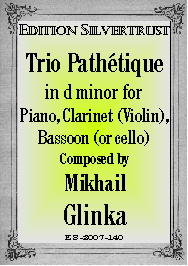Presents
Mikhail Glinka
Trio Pathétique in d minor
for Clarinet, Bassoon & Piano or Violin, Cello & Piano
 Mikhail
Glinka (1804-57) was the first within Russia to create romances, operas and
chamber music on based on Russian themes using Russian folk melodies and is commonly regarded as the founder of Russian nationalism in
music. His influence on composers such as Rimsky-Korsakov, Borodin and
Mussorgsky was considerable. As a child, he had some lessons from the famous
Irish virtuoso pianist John Field who was living in Petersburg, but his
association with music remained purely amateur, until visits to Europe which
began in 1830. In both Italy and Germany, he was able to formally study and
improve his compositional technique. His music offered a synthesis of Western
operatic form with Russian melody, while his instrumental music was a
combination of the traditional and the exotic.
Mikhail
Glinka (1804-57) was the first within Russia to create romances, operas and
chamber music on based on Russian themes using Russian folk melodies and is commonly regarded as the founder of Russian nationalism in
music. His influence on composers such as Rimsky-Korsakov, Borodin and
Mussorgsky was considerable. As a child, he had some lessons from the famous
Irish virtuoso pianist John Field who was living in Petersburg, but his
association with music remained purely amateur, until visits to Europe which
began in 1830. In both Italy and Germany, he was able to formally study and
improve his compositional technique. His music offered a synthesis of Western
operatic form with Russian melody, while his instrumental music was a
combination of the traditional and the exotic.
The Trio Pathétique dates from around 1827-8, well after his piano studies with Field but before he embarked on his travels. It was originally for the combination of Clarinet, Bassoon and Piano but Glinka's publisher insisted he also make a version for standard piano trio which he did. One can hear Russian folk melody, which he must have heard from the serf musicians of his uncle’s orchestra, however, it is expressed in the idiom of the Viennese classics. The opening Allegro moderato is in the transitional style of early Romanticism with a classical structure. In the second movement Scherzo, the piano is given a sparkling part against which the others have long-breathed lyrical passages. The tuneful trio recalls early Beethoven. The trio's center of gravity is its third movement, Largo. The sobriquet "pathétique" no doubt comes from the melodies given to the winds (strings), especially the lower voice. The running triplets which characterize the exciting finale, Allegro con spirito, eventually give way to what must be the original basis of the thrilling movie music used in silent films.
This is a great little work which sounds equally well with winds and strings. Though by no means music that plumbs the depths, it nonetheless would do well in concert as well as on home music stands.